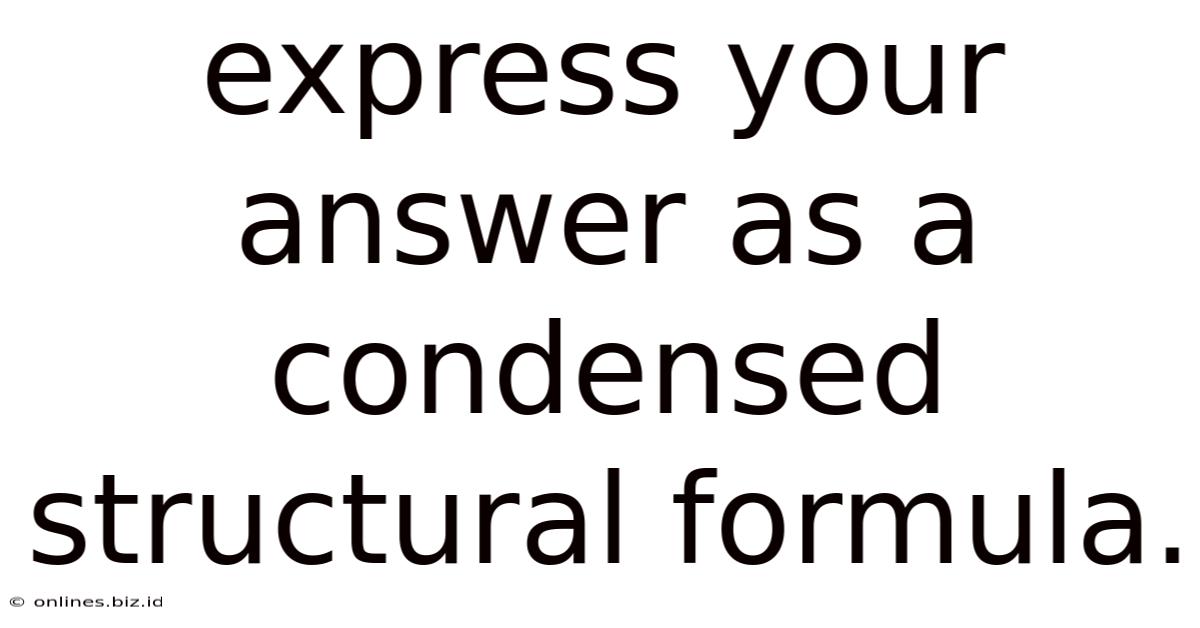Express Your Answer As A Condensed Structural Formula.
Onlines
May 12, 2025 · 4 min read

Table of Contents
Express Your Answer as a Condensed Structural Formula: A Comprehensive Guide
Condensed structural formulas are a crucial tool in organic chemistry, providing a concise yet informative way to represent the structure of molecules. Unlike skeletal formulas, which prioritize showing the carbon skeleton, condensed formulas explicitly depict all atoms and bonds, albeit in a simplified manner. Mastering this representation is key to understanding and communicating complex organic structures efficiently. This guide will delve into the intricacies of condensed structural formulas, exploring their construction, interpretation, and applications.
Understanding the Basics of Condensed Structural Formulas
A condensed structural formula condenses the detailed representation of a molecule by omitting explicitly drawing all carbon-carbon and carbon-hydrogen bonds. Instead, it groups atoms directly bonded to a carbon atom together. This significantly reduces the visual clutter while still preserving the essential information about the molecule's connectivity and composition.
For example, consider butane. Its full structural formula is:
CH3-CH2-CH2-CH3
The condensed structural formula simplifies this to:
CH3CH2CH2CH3
or, even more concisely:
CH3(CH2)2CH3
Key Principles of Writing Condensed Structural Formulas
Several key principles guide the construction of accurate and unambiguous condensed structural formulas:
1. Parent Chain Identification:
The longest continuous carbon chain forms the basis of the formula. This chain is often written linearly, forming the backbone of the structure.
2. Branching and Substituents:
Any branching or substituent groups (atoms or groups of atoms attached to the main chain) are written immediately after the carbon atom to which they are attached. Parentheses are used to group atoms attached to the same carbon.
Example: 2-methylpropane
Full Structural Formula:
CH3
|
CH3-CH-CH3
Condensed Structural Formula:
CH3CH(CH3)CH3
3. Functional Groups:
Functional groups, characteristic atoms or groups of atoms with specific chemical properties, are included explicitly in their condensed form. For example, a hydroxyl group (-OH) in an alcohol, a carboxyl group (-COOH) in a carboxylic acid, or an amino group (-NH2) in an amine.
Example: Ethanol
Full Structural Formula:
CH3-CH2-OH
Condensed Structural Formula:
CH3CH2OH
4. Multiple Bonds:
Double and triple bonds are explicitly shown using = and ≡ respectively.
Example: Ethene
Full Structural Formula:
H2C=CH2
Condensed Structural Formula:
CH2=CH2
5. Cyclic Structures:
Cyclic structures require a slightly different approach. The ring structure is often represented by a polygon, with substituents indicated outside the polygon. Condensed formulas can also be used, but they become more complex for larger rings.
Example: Cyclohexane
Full Structural Formula: (A hexagon representing the ring)
Condensed Structural Formula: (Often represented as C6H12, requiring knowledge of the cyclic structure)
Advanced Applications and Examples
Condensed structural formulas become particularly useful when dealing with complex organic molecules containing multiple functional groups and branching. Let's examine some more intricate examples:
1. 2,3-dimethylpentane:
This molecule has a five-carbon parent chain with methyl groups attached to carbons 2 and 3.
Condensed Structural Formula: CH3CH(CH3)CH(CH3)CH2CH3
2. 3-ethyl-2,4-dimethylhexane:
A more complex example with an ethyl group and two methyl groups as substituents.
Condensed Structural Formula: CH3CH(CH3)CH(C2H5)CH(CH3)CH2CH3
3. 2-bromo-3-chloro-butanoic acid:
This molecule showcases a carboxylic acid functional group along with bromine and chlorine substituents.
Condensed Structural Formula: CH3CH(Br)CH(Cl)COOH
4. 3-methyl-2-pentanone:
This example demonstrates a ketone functional group (C=O) within the chain.
Condensed Structural Formula: CH3CH(CH3)COCH2CH3
Limitations and Alternatives
While condensed structural formulas offer a concise representation, they do have limitations. They might not always be as clear as full structural formulas, especially for complex molecules with intricate branching or stereochemistry. In such cases, skeletal formulas might provide a clearer visual representation.
Other representations such as IUPAC nomenclature (systematic naming of organic compounds) provide an alternative, textual method for unambiguously identifying molecules. A skilled chemist needs to be adept at navigating between all these different representations to understand and communicate about organic molecules effectively.
Interpreting Condensed Structural Formulas
Being able to interpret condensed structural formulas is just as important as constructing them. To effectively interpret, follow these steps:
-
Identify the Parent Chain: Begin by identifying the longest continuous carbon chain.
-
Locate Substituents: Find the branching points and identify the substituent groups attached to the main chain.
-
Recognize Functional Groups: Look for characteristic functional groups and note their positions.
-
Deduce Connectivity: Use the arrangement of atoms and parentheses to infer how the atoms are bonded together.
-
Visualize the Structure: If needed, draw out the full structural formula to clarify the molecule's three-dimensional arrangement.
Conclusion: Mastering the Power of Condensed Structural Formulas
Condensed structural formulas represent a vital skill for any student or professional working with organic chemistry. Their ability to condense complex information into a manageable format allows for efficient communication and understanding of organic molecule structure. By mastering the principles outlined in this guide, you can enhance your ability to effectively represent, interpret, and manipulate organic molecules, ultimately furthering your understanding of the fascinating world of organic chemistry. Remember that practice is key – the more you work with condensed structural formulas, the more intuitive they will become.
Latest Posts
Related Post
Thank you for visiting our website which covers about Express Your Answer As A Condensed Structural Formula. . We hope the information provided has been useful to you. Feel free to contact us if you have any questions or need further assistance. See you next time and don't miss to bookmark.